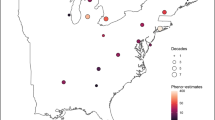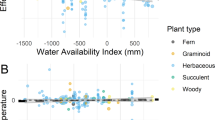Abstract
Spatial synchrony, the tendency of distant populations to fluctuate similarly, is a major concern in ecology1,2,3,4,5,6,7,8. Except in special circumstances3,9, researchers historically had difficulty identifying drivers of synchrony in field systems5,6,10. Perhaps for this reason, the possibility9,11,12 that changes in large-scale climatic drivers may modify synchrony, thereby impacting ecosystems and human concerns, has been little examined. Here, we use wavelets to determine environmental drivers of phenological synchrony across Britain for 20 aphid species, most major crop pests. Consistently across species, changes in drivers produced large changes in aphid synchrony. Different drivers acted on different timescales: using a new wavelet analogue of the Moran theorem1, we show that on long timescales (>4 years), 80% of synchrony in aphid first flights is due to synchrony in winter climate; but this explanation accounts for less short-timescale (≤4 years) synchrony. Changes in aphid synchrony over time also differed by timescale: long-timescale synchrony fell from before 1993 to after, caused by similar changes in winter climate; whereas short-timescale synchrony increased. Shifts in winter climate are attributable to the North Atlantic Oscillation, an important climatic phenomenon7,11,13, so effects described here may influence other taxa. This study documents a new way that climatic changes influence populations, through altered Moran effects.
This is a preview of subscription content, access via your institution
Access options
Subscribe to this journal
Receive 12 print issues and online access
$209.00 per year
only $17.42 per issue
Buy this article
- Purchase on Springer Link
- Instant access to full article PDF
Prices may be subject to local taxes which are calculated during checkout



Similar content being viewed by others
References
Moran, P. The statistical analysis of the Canadian lynx cycle, II. Aust. J. Zool. 1, 291–298 (1953).
Hanski, I. & Woiwod, I. Spatial synchrony in the dynamics of moth and aphid populations. J. Anim. Ecol. 62, 656–668 (1993).
Grenfell, B. et al. Noise and determinism in synchronized sheep dynamics. Nature 394, 674–677 (1998).
Lande, R., Engen, S. & Sæther, B. Spatial scale of population synchrony: Environmental correlation versus dispersal and density regulation. Am. Nat. 154, 271–281 (1999).
Bjørnstad, O., Ims, R. & Lambin, X. Spatial population dynamics: Analyzing patterns and processes of population synchrony. Trends Ecol. Evol. 14, 427–432 (1999).
Liebhold, A., Koenig, W. & Bjørnstad, O. Spatial synchrony in population dynamics. Annu. Rev. Ecol. Evol. Syst. 35, 467–490 (2004).
Engen, S., Lande, R., Sæther, B. & Bregnballe, T. Estimating the pattern of synchrony in fluctuating populations. J. Anim. Ecol. 74, 601–611 (2005).
Vasseur, D. & Fox, J. Phase-locking and environmental fluctuations generate synchrony in a predator–prey community. Nature 460, 1007–1010 (2009).
Post, E. & Forchhammmer, M. Synchronization of animal population dynamics by large-scale climate. Nature 420, 168–171 (2002).
Abbott, K. Does the pattern of population synchrony through space reveal if the Moran effect is acting? Oikos 116, 903–912 (2007).
Stenseth, N. et al. Ecological effects of climate fluctuations. Science 297, 1292–1296 (2002).
Ojanen, S., Niemenen, M., Meyke, E., Pöyry, J. & Hanski, I. Long-term metapopulation study of the Glanville fritillary butterfly (Melitaea cinxia): Survey methods, data management, and long-term population trends. Ecol. Evol. 3, 3713–3737 (2013).
Ottersen, G. et al. Ecological effects of the North Atlantic Oscillation. Oecologia 128, 1–14 (2001).
Bjørnstad, O., Peltonen, M., Liebhold, A. & Baltensweiler, W. Waves of larch budmoth outbreaks in the European alps. Science 298, 1020–1023 (2002).
Beaugrand, G., Brander, K., Lindley, J., Souissi & Reid, P. Plankton effect on cod recruitment in the North Sea. Nature 426, 661–664 (2003).
Stenseth, N. et al. The effect of climatic forcing on population synchrony and genetic structuring of the Canadian lynx. Proc. Natl Acad. Sci. USA 101, 6056–6061 (2004).
Haynes, K., Bjørnstad, O., Allstadt, A. & Liebhold, A. Geographic variation in the spatial synchrony of a forest-defoliating insect: Isolation of environmental and spatial drivers. Proc. R. Soc. B 280, 20122373 (2013).
Micheli, F. The dual nature of community variability. Oikos 85, 161–169 (1999).
Vasseur, D. & Gaedke, U. Spectral analysis unmasks synchronous and compensatory dynamics in plankton communities. Ecology 88, 2058–2071 (2007).
Keitt, T. Coherent ecological dynamics induced by large-scale disturbance. Nature 454, 331–335 (2008).
Earn, D., Levin, S. & Rohani, P. Coherence and conservation. Science 290, 1360–1364 (2000).
Dixon, A. Aphid Ecology: An Optimization Approach 2nd edn (Chapman and Hall, 1998).
Van Emden, H. & Harrington, R. Aphids as Crop Pests (CAB International, 2007).
Estay, S., Lima, M. & Harrington, R. Climate mediated exogenous forcing and synchrony in populations of the oak aphid in the UK. Oikos 118, 175–182 (2009).
Post, E. & Forchhammer, M. C. Spatial synchrony of local populations has increased in association with the recent northern hemisphere climate trend. Proc. Natl Acad. Sci. USA 101, 9286–9290 (2004).
Sheppard, L. W., Stefanovska, A. & McClintock, P. V. E. Testing for time-localized coherence in bivariate data. Phys. Rev. E 85, 046205 (2012).
Harrington, R., Bale, J. & Tatchell, G. in Insects in a Changing Environment (eds Harrington, R. & Stork, N.) 125–155 (Academic Press, 1995).
Bjørnstad, O. & Falck, W. Nonparametric spatial covariance functions: Estimation and testing. Environ. Ecol. Stat. 8, 53–70 (2001).
Fontaine, C. & Gonzalez, A. Population synchrony induced by resource fluctuations and dispersal in an aquatic microcosm. Ecology 86, 1463–1471 (2005).
Peltonen, M., Liebhold, A., Bjørnstad, O. & Williams, D. Spatial synchrony in forest insect outbreaks: Roles of regional stochasticity and dispersal. Ecology 83, 3120–3129 (2002).
Macaulay, E., Tatchell, G. & Taylor, L. The Rothamsted Insect Survey 12-metre suction trap. Bull. Entomol. Res. 78, 121–129 (1988).
Harrington, R. The Rothamsted Insect Survey strikes gold. Antenna 38, 158–166 (2014).
Hurrell, J. & National Center for Atmospheric Research Staff The Climate Data Guide: Hurrell North Atlantic Oscillation (NAO) Index (Station-based) (NCAR, accessed 15 January 2015); https://climatedataguide.ucar.edu/climate-data/hurrell-north-atlantic-oscillation-nao-index-station-based.
National Center for Atmospheric Research Staff. The Climate Data Guide: Hurrell North Atlantic Oscillation (NAO) Index (PC-based) (NCAR, accessed 15 January 2015); https://climatedataguide.ucar.edu/climate-data/hurrell-north-atlantic-oscillation-nao-index-pc-based.
UK Climate: Historical Station Data (UK Met Office, accessed 15 January 2015); http://www.metoffice.gov.uk/public/weather/climate-historic/#?tab=climateHistoric.
Grenfell, B., Bjørnstad, O. & Kappey, J. Traveling waves and spatial hierarchies in measles epidemics. Nature 414, 716–723 (2001).
Viboud, C. et al. Synchrony, waves, and spatial hierarchies in the spread of influenza. Science 312, 447–451 (2006).
Keitt, T. & Fischer, J. Detection of scale-specific community dynamics using wavelets. Ecology 87, 2895–2904 (2006).
Cazelles, B. et al. Wavelet analysis of ecological timeseries. Oecologia 156, 287–304 (2008).
Bell, J. et al. Putting the brakes on a cycle: Bottom-up effects damp cycle amplitude. Ecol. Lett. 15, 310–318 (2012).
Cazelles, B., Cazelles, K. & Chavez, M. Wavelet analysis in ecology and epidemiology: Impact of statistical tests. J. R. Soc. Interface 11, 20130585 (2014).
Rouyer, T., Fromentin, J., Stenseth, N. & Cazelles, B. Analysing multiple time series and extending significance testing in wavelet analysis. Mar. Ecol. Prog. Ser. 359, 11–23 (2008).
Torrence, C. & Compo, G. P. A practical guide to wavelet analysis. Bull. Am. Meteorol. Soc. 79, 61–78 (1998).
Addison, P. S. The Illustrated Wavelet Transform Handbook: Introductory Theory and Applications in Science, Engineering, Medicine and Finance (Taylor and Francis, 2002).
Meyers, S., Kelly, B. & O’Brien, J. An introduction to wavelet analysis in oceanography and meteorology: With application to the dispersion of yanai waves. Mon. Weath. Rev. 121, 2858–2866 (1993).
Bandrivskyy, A., Bernjak, A., McClintock, P. V. E. & Stefanovska, A. Wavelet phase coherence analysis: Application to skin temperature and blood flow. Cardiovasc. Eng. 4, 89–93 (2004).
Stefanovska, A. Coupled oscillators—complex but not complicated cardiovascular and brain interactions. IEEE Eng. Med. Biol. 26, 25–29 (2007).
Theiler, J., Eubank, S., Longtin, A., Galdrikian, B. & Farmer, J. Testing for nonlinearity in time series: The method of surrogate data. Physica D 58, 77–94 (1992).
Prichard, D. & Theiler, J. Generating surrogate data for time series with several simultaneously measured variables. Phys. Rev. Lett. 73, 951–954 (1994).
Jones, J., Doran, P. & Holmes, R. Climate and food synchronize regional forest bird abundances. Ecology 84, 3024–3032 (2003).
Grøtan, V. et al. Climate causes large-scale spatial synchrony in population fluctuations of a temperate herbivore. Ecology 86, 1472–1482 (2005).
Sæther, B. et al. The extended Moran effect and large-scale synchronous fluctuations in the size of great tit and blue tit populations. J. Anim. Ecol. 76, 315–325 (2007).
Schreiber, T. & Schmitz, A. Surrogate time series. Physica D 142, 346–382 (2000).
Sakia, R. The Box–Cox transformation technique: A review. Statistician 41, 169–178 (1992).
Acknowledgements
We thank contributors to the Rothamsted Insect Survey; P. Verrier for data extraction; and B. Cazelles, J. E. Cohen, R. Costantino, R. Desharnais, E. Defriez, J. Kastens, B. Mechtley and C. Reid for advice and discussions. The Rothamsted Insect Survey is a UK BBSRC-supported National Capability. L.W.S. was supported and D.C.R. was partly supported by UK NERC grants NE/H020705/1, NE/I010963/1 and NE/I011889/1 and funding from the University of Kansas. Travel was facilitated by US National Science Foundation grant DMS-1225529.
Author information
Authors and Affiliations
Contributions
L.W.S. and D.C.R. designed and carried out the analysis and wrote the paper. Data and interpretive assistance were provided by J.R.B. and R.H. All authors contributed to editing.
Corresponding authors
Ethics declarations
Competing interests
The authors declare no competing financial interests.
Supplementary information
Rights and permissions
About this article
Cite this article
Sheppard, L., Bell, J., Harrington, R. et al. Changes in large-scale climate alter spatial synchrony of aphid pests. Nature Clim Change 6, 610–613 (2016). https://doi.org/10.1038/nclimate2881
Received:
Accepted:
Published:
Issue Date:
DOI: https://doi.org/10.1038/nclimate2881
This article is cited by
-
Multidecadal, continent-level analysis indicates agricultural practices impact wheat aphid loads more than climate change
Communications Biology (2022)
-
Reduced resilience of terrestrial ecosystems locally is not reflected on a global scale
Communications Earth & Environment (2021)
-
Identifying the paths of climate effects on population dynamics: dynamic and multilevel structural equation model around the annual cycle
Oecologia (2021)
-
Minimal effect of prescribed burning on fire spread rate and intensity in savanna ecosystems
Stochastic Environmental Research and Risk Assessment (2021)
-
Temporal Coherence Between Lake and Landscape Primary Productivity
Ecosystems (2021)



